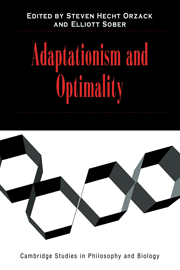Book contents
- Frontmatter
- Contents
- Contributors
- Acknowledgments
- Introduction
- 1 A Likelihood Framework for the Phylogenetic Analysis of Adaptation
- 2 Adaptation, Phylogenetic Inertia, and the Method of Controlled Comparisons
- 3 Optimality and Phylogeny: A Critique of Current Thought
- 4 Fit of Form and Function, Diversity of Life, and Procession of Life as an Evolutionary Game
- 5 Optimality and Evolutionary Stability under Short-Term and Long-Term Selection
- 6 Selective Regime and Fig Wasp Sex Ratios: Toward Sorting Rigor from Pseudo-Rigor in Tests of Adaptation
- 7 Is Optimality Over the Hill? The Fitness Landscapes of Idealized Organisms
- 8 Adaptation, Optimality, and the Meaning of Phenotypic Variation in Natural Populations
- 9 Adaptationism, Optimality Models, and Tests of Adaptive Scenarios
- 10 Adaptation and Development: On the Lack of Common Ground
- 11 Three Kinds of Adaptationism
- 12 Adaptation, Adaptationism, and Optimality
- Index
6 - Selective Regime and Fig Wasp Sex Ratios: Toward Sorting Rigor from Pseudo-Rigor in Tests of Adaptation
Published online by Cambridge University Press: 06 January 2010
- Frontmatter
- Contents
- Contributors
- Acknowledgments
- Introduction
- 1 A Likelihood Framework for the Phylogenetic Analysis of Adaptation
- 2 Adaptation, Phylogenetic Inertia, and the Method of Controlled Comparisons
- 3 Optimality and Phylogeny: A Critique of Current Thought
- 4 Fit of Form and Function, Diversity of Life, and Procession of Life as an Evolutionary Game
- 5 Optimality and Evolutionary Stability under Short-Term and Long-Term Selection
- 6 Selective Regime and Fig Wasp Sex Ratios: Toward Sorting Rigor from Pseudo-Rigor in Tests of Adaptation
- 7 Is Optimality Over the Hill? The Fitness Landscapes of Idealized Organisms
- 8 Adaptation, Optimality, and the Meaning of Phenotypic Variation in Natural Populations
- 9 Adaptationism, Optimality Models, and Tests of Adaptive Scenarios
- 10 Adaptation and Development: On the Lack of Common Ground
- 11 Three Kinds of Adaptationism
- 12 Adaptation, Adaptationism, and Optimality
- Index
Summary
We use a detailed case study to identify considerations that are likely to be important in constructing and interpreting tests of the optimality of adaptations. Specifically, we consider the sex ratio responses in natural populations of 15 fig-pollinating wasp species and the predictions of local mate competition theory. The mean sex ratios exhibited by fig wasps show qualitative and often quantitative agreement to a wide range of predictions of these models. However, we also find (1) deviations of mean responses from theoretical optima, (2) variation among individuals in their responses to given situations, and (3) unresolved doubts concerning the parameterization and applicability of the models used to predict optimal brood sex ratios. A fundamental question in interpretation arises: Are we using the theory to test the precision of adaptation, or are we using the responses to test the precision of the models? A partial solution to this problem is offered by the fact that within and across these fig wasp species, the frequency with which any particular situation occurs (i.e., selective regime) can be estimated. Across species, the deviations from the predicted optima are fewest in the situations most frequently encountered by the organisms. Similarly, variance in the responses of individuals is lowest for those situations most commonly encountered. Furthermore, phylogenetic relationships of the wasps have little or no relationship with means, deviations, or variance of their sex ratios, suggesting that these characters evolve very rapidly with respect to speciation and are not correlated with other characters that are themselves closely correlated with phylogenetic relationships.
Information
- Type
- Chapter
- Information
- Adaptationism and Optimality , pp. 191 - 218Publisher: Cambridge University PressPrint publication year: 2001
Accessibility standard: Unknown
Why this information is here
This section outlines the accessibility features of this content - including support for screen readers, full keyboard navigation and high-contrast display options. This may not be relevant for you.Accessibility Information
- 38
- Cited by
